Galapagos Species Database
The Galapagos Species Database shares the information about the species from our Natural History Collections.
Buteo galapagoensis
Gavilán de Galápagos, Galapagos Hawk

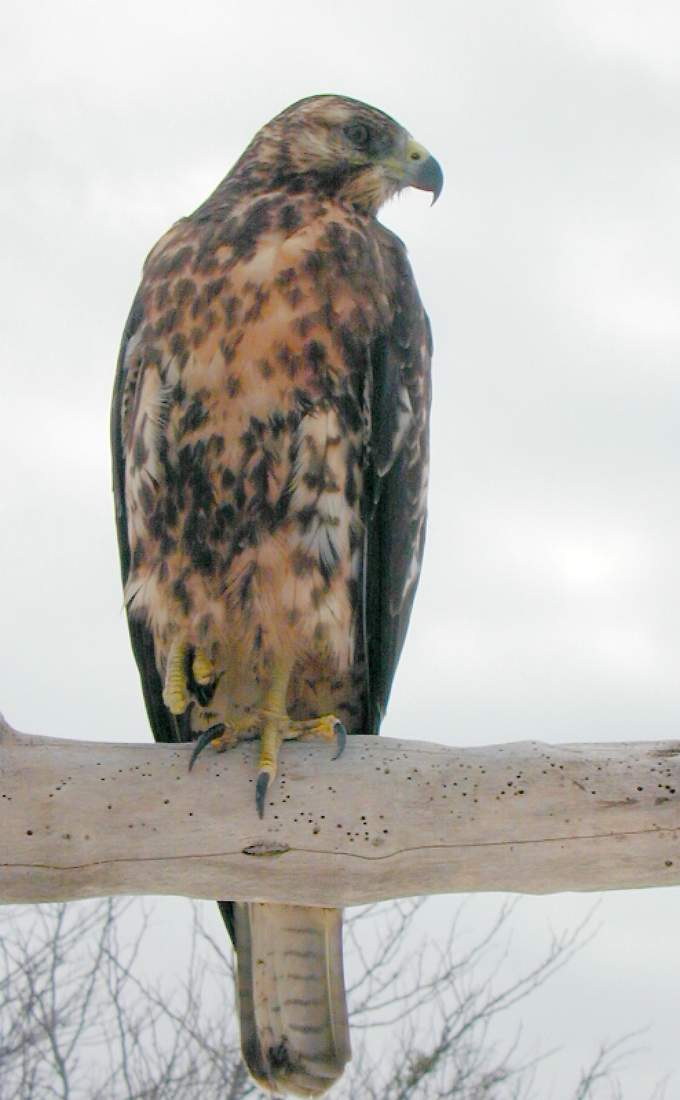
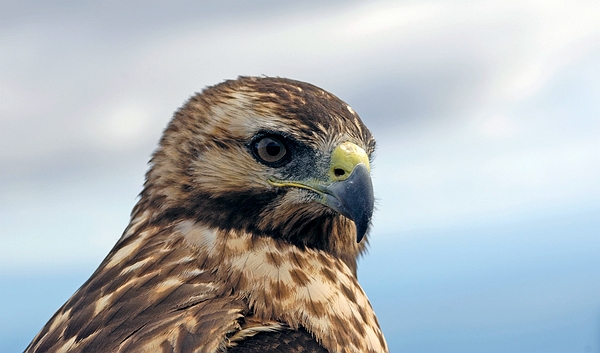
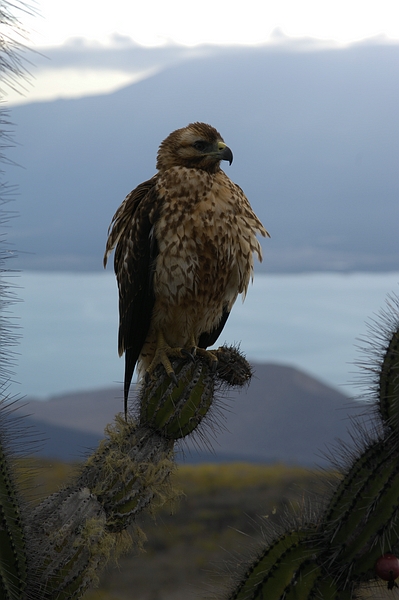



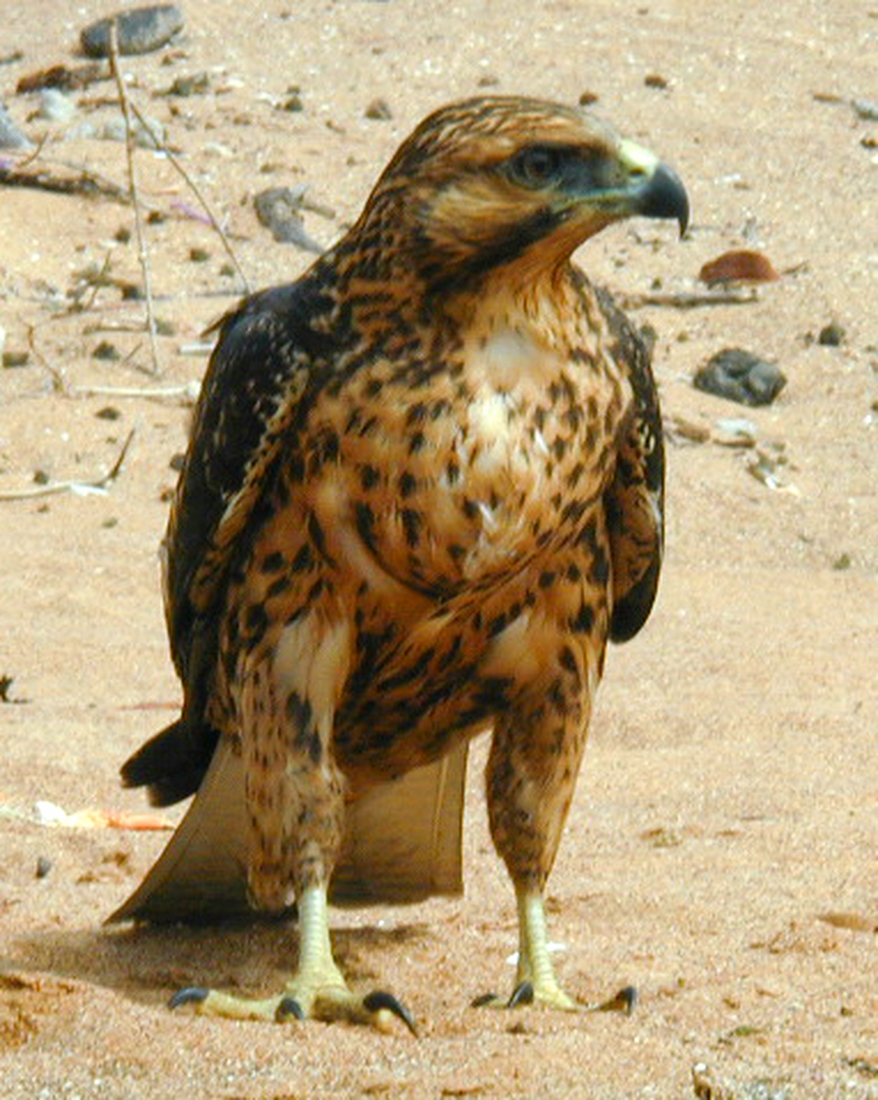
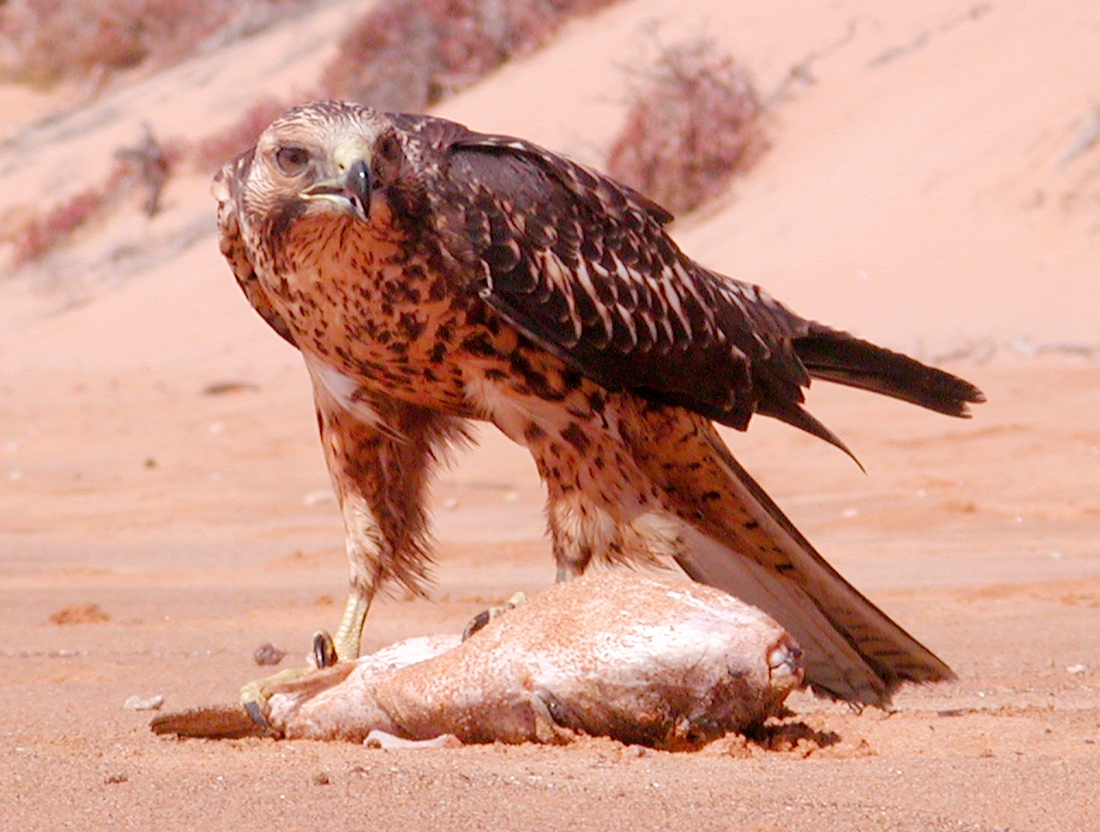
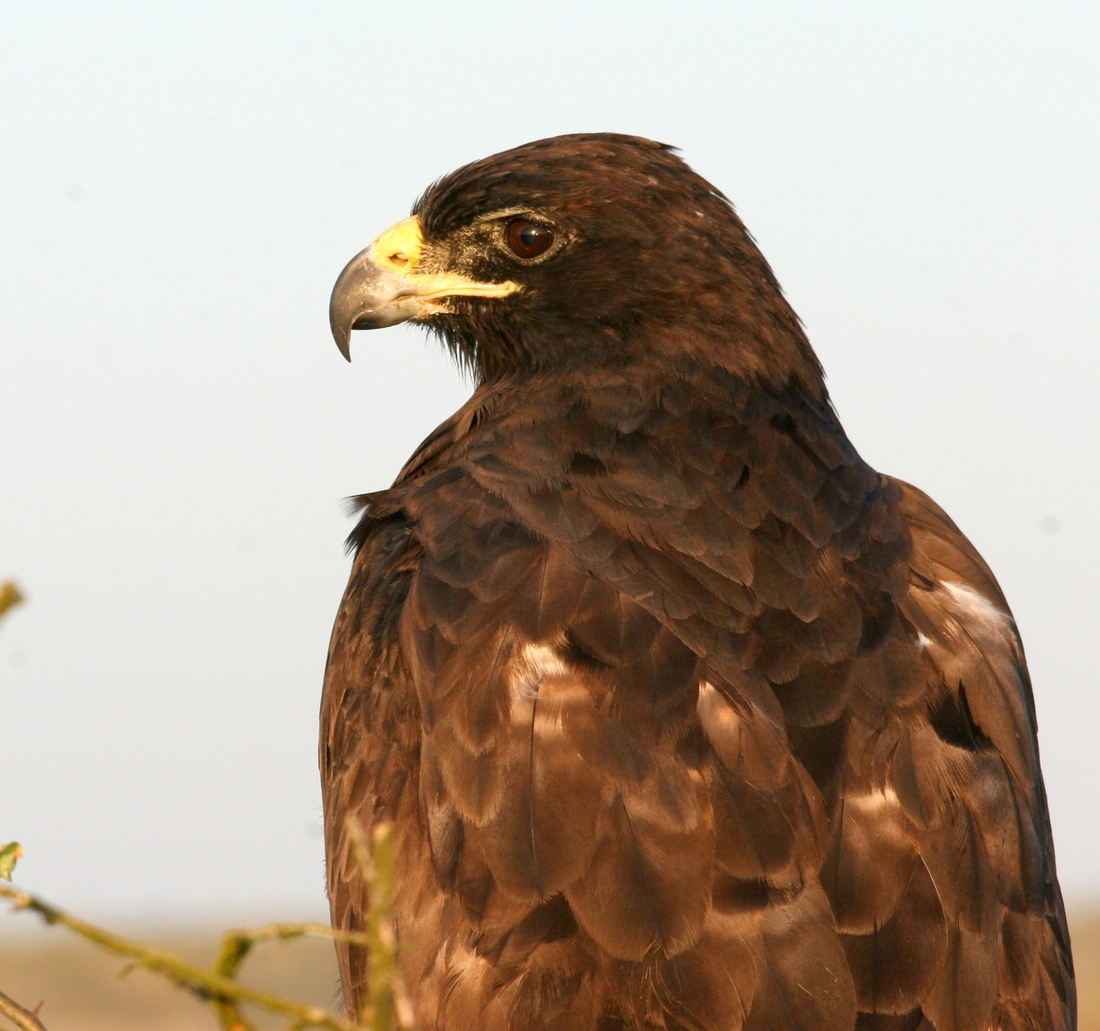
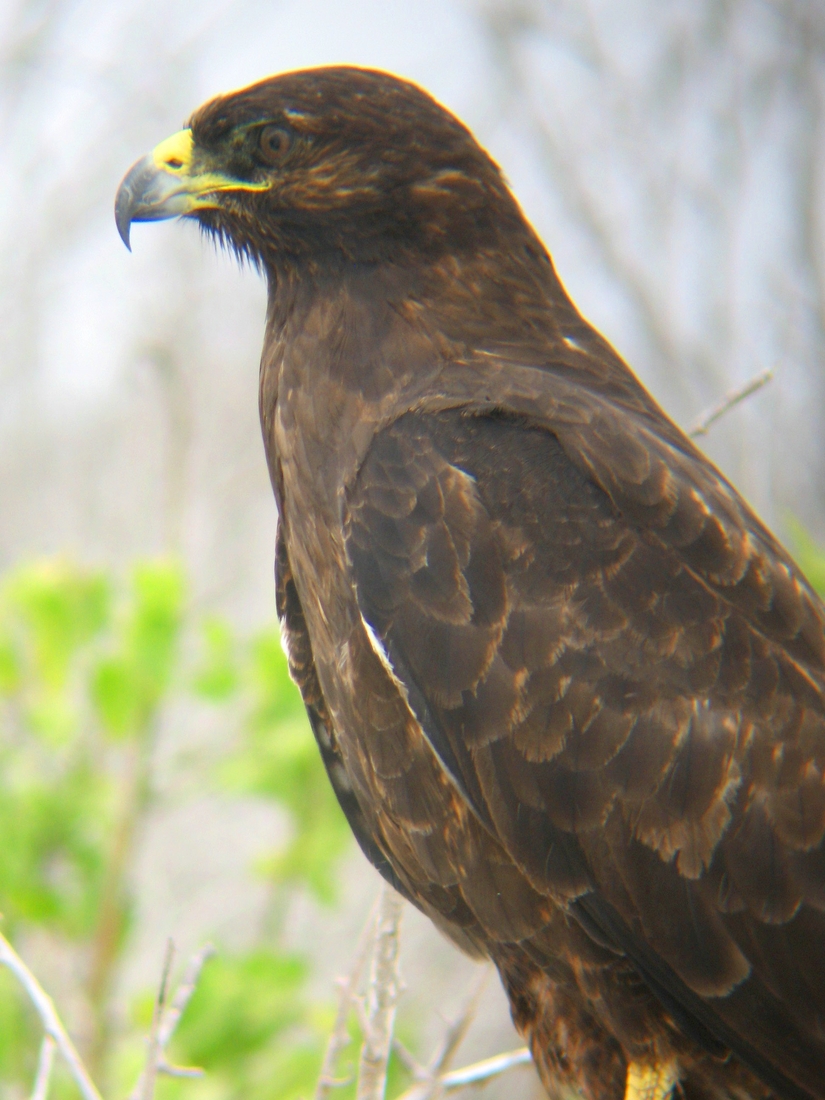
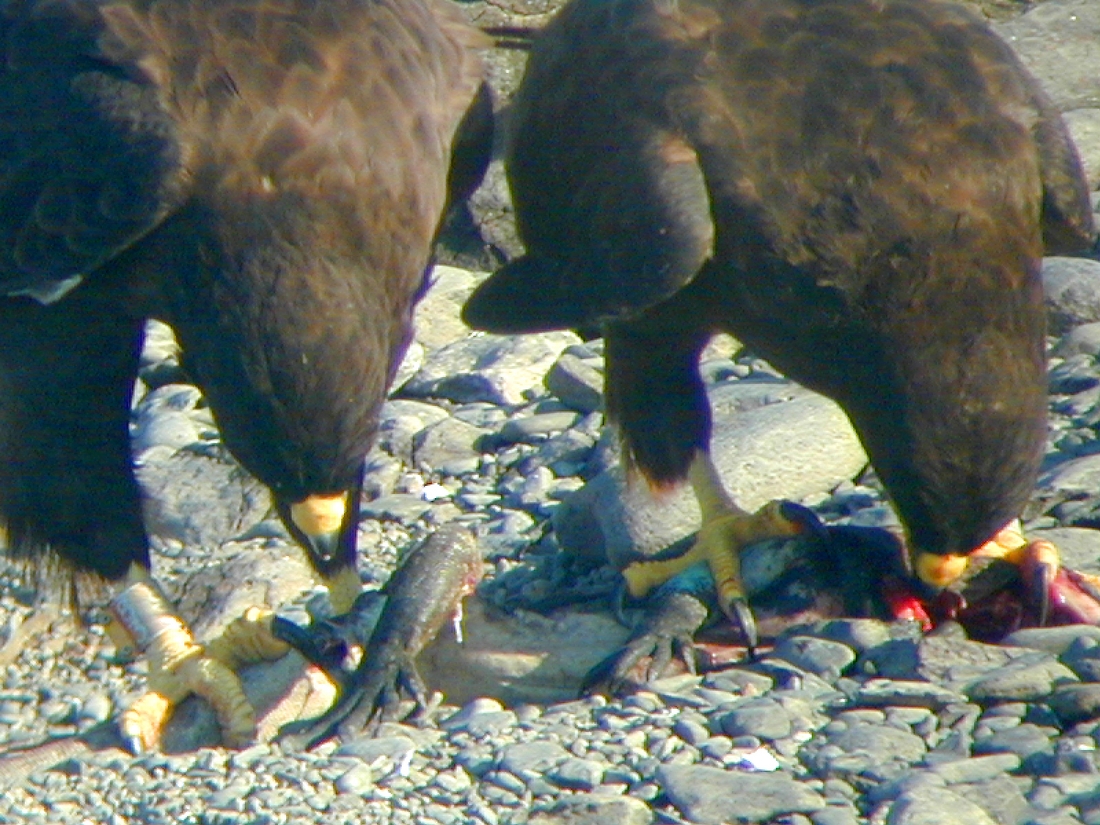

Length 56 cm, wingspan 120 cm. The only large and dark, broad winged bird likely to be seen sitting in a tree or circling high in the sky. Adult almost is black except for some chestnut on under parts and a grey or brown tail crossed by about nine darker bands. Immature has body buff colored, mottled with dark brown. Recently fledged juveniles have breast and belly bright chestnut. Bill dark with yellow cere or fleshy base, and feet are yellow. Female is larger than male (Harris 1974; Castro & Phillips 1996).
Threats Dependant on food availability. May be affected by the toxins used for the control of feral mammals, particularly rats.
Domain
Eukaryota
Kingdom
Animalia
Phylum
Chordata
Class
Aves
Order
Accipitriformes
Family
Accipitridae
Genus
Buteo
Species
galapagoensis
Taxon category: Accepted
Syn.: Polyborus galapagoensis Gould, 1837; Craxirex galapagoensis Gould, 1837; Buteo galapagensis Sundevall, 1871; Buteo galapagoensis Ridgway, 1890
Taxon origin: Endemic
Preference for an altitude zone in Galapagos: Coastal zone - high altitude dry zone
Feeding type: Feeds on number of birds, small mammals, and lizards. It is the only serious predator of marine iguanas who react actively to hawks flying over the colonies. Goats used to provide a good food source both through natural death and in the hunting seasons, this resource is much depleted. The consequences are unknown
Trophic role: Carnivorous
Reproductive biology: On Isabela, Marchena and Pinta, Galapagos Hawks are 100 % polyandrous, one female mating with 2-8 males that form a group defending a territory year round. All the males contribute cooperatively to the care of the brood. Outside the breeding territories, non breeding females and immature males, form a floating population. On Santiago and Santa Fé, only a proportion exhibit polyandry, on Espanola the population is monogamous. Each male in a polyandrous group has fewer offspring than monogamous males, but they have a higher survival rate.
Distribution: Present on almost all islands, with exception of Genovesa, Wolf, Darwin. Extinct on Santa Cruz, San Cristobal, Floreana, Baltra. Genetic information shows no gene flow between island populations, and hence a relative isolation of sub-populations. The species could be in the first stages of diversi
- Wiedenfeld, D.A. (2006) Aves, the Galapagos Islands, Ecuador. Check List 2006 2(2): 1-27.
- Jiménez-Uzcátegui, G. Milstead, B., Márquez, C., Zabala, J., Buitrón, P., Llerena, A., et al. (2007) Galapagos vertebrates: endangered status and conservation actions. Galapagos Report 2006–2007. Charles Darwin Foundation, Puerto Ayora, p. 104–110.
- Granizo, T. Pacheco, C., Rivadeneira, M. B., Guerrero M. & Suárez, L. (eds.) (2002) Libro Rojo de las Aves del Ecuador. SIMBIOE/Conservation International/EcoCiencia/Ministerio del Ambiente/IUCN. Serie Libros Rojos del Ecuador, tomo 2. Quito, Ecuador.
- Harris, M.P. (1973) The Galápagos avifauna. Condor 75(3): 265-278.
- Salvin, O. (1876) On the avifauna of the Galápagos Archipelago. Transactions of the Zoological Society of London 9: 447-510.
- Sundevall, C.J. (1871) On birds from the Galápagos Islands. Proceedings of the Zoological Society of London 1871: 124-129.
- Swarth, H.S. (1931) The Avifauna of the Galapagos Islands. Occ. Pap. Calif. Acad. Sci. 18: 1-299.
- Whiteman, N.K. Parker, P.G. (2004) Body condition and parasite load predict territory ownership in the Galápagos Hawk. The Condor 106: 915–921.
- Whiteman, N.K. Matson, K.D., Bollmer, J.L. & Parker, P.G. (2006) Disease ecology in the Galápagos Hawk (Buteo galapagoensis): host genetic diversity, parasite load and natural antibodies. Proceedings of the Royal Society B 273: 797–804.
- Whiteman, N.K. Parker, P.G. (2004) Effects of host sociality on ectoparasite population biology. The Journal of Parasitology 90(5): 939–947.
- Whiteman, N.K. Kimball, R.T. & Parker, P.G. (2007) Co-phylogeography and comparative population genetics of the threatened Galápagos hawk and three ectoparasite species: ecology shapes population histories within parasite communities. Molecular Ecology 22: 4759-4773.
- Whiteman, N.K. Sánchez, P., Merkel, J., Klompen, H. & Parker, P.G. (2006) Cryptic host specificity of an avian skin mite (Epidermoptidae) vectored by louseflies (Hippoboscidae) associated with two endemic Galápagos bird species. The Journal of Parasitology, 92(6): 1218-1228.
- Whiteman, N.K. Dosanjh, V.S., Ricardo L. Palma, R.L., Hull, J. M., Kimball, R.T., Sánchez, P., Sarasola, H.S & Parker, P.G. (2009) Molecular and morphological divergence in a pair of bird species and their ectoparasites. Journal of Parasitology 95(6): 1372–1382.
- Peters, M.P. Hagen, C., Whiteman, N.K., Parker, P.G. & Glenn, T.C. (2009) Characterization of 10 microsatellite loci in an avian louse, Degeeriella regalis (Phthiraptera: Ischnocera: Philopteridae). Molecular Ecology Resources 9(3): 882-884.
- Peters, M.P. Whiteman, N.K., Hagen, C., Parker, P.G. & Glenn, T.C. (2009) Eight polymorphic microsatellite markers isolated from the widespread avian louse Colpocephalum turbinatum (Phthiraptera: Amblycera: Menoponidae). Molecular Ecology Resources 9(3): 910-912.
- Whiteman, N.K. Santiago-Alarcon, D. (2004) Differences in straggling rates between two genera of dove lice (Insecta: Phthiraptera) reinforce population genetic and cophylogenetic patterns. International Journal for Parasitology 34: 1113-1119.
- Parker, P.G. Whiteman, N.K., & Miller, R.E. (2006) Conservation medicine on the Galápagos Islands: partnerships among behavioral, population, and veterinarian scientists. The Auk 123(3): 625-638.
- Santiago-Alarcon, D. Whiteman, N.K., Parker, P.G., Ricklefs, R.E. & Valkiūnas, G. (2008) Patterns of parasite abundance and distribution in island populations of Galápagos endemic birds. Journal of Parasitology 94(3): 584–590.
- Wiedenfeld, D.A. Jiménez-Uzcátegui, G. (2008) Critical problems for bird conservation in the Galapagos Island. Cotinga 29: 22-27.
- Hickin, N. (1979) Animal life of the Galapagos. Ferundune Books, Faringdon, U.K., 236 pp.
- Lanteri, A.A. (2001) Biogeografía de las Islas Galápagos: Principales aportes de los estudios filogenéticos. Introducción a la Biogeografia en Latinoamérica: Conceptos, teorías, métodos y aplicacions. Vol. I, Ciencias, UNAM, México Pp. 141-151.
- Bisconti, M. Landini, W., Bianucci, G., Cantalamessa, G., Carnevale, G. Ragaini, L. & Valleri, G. (2001) Biogeographic relationships of the Galapagos terrestrial biota: parsimony analyses of endemicity based on reptiles, land birds and Scalesia land plants. J. Biogeogr. 28: 495-510.
- Loope, L.L. Hamann, O. & Stone, C.P. (1987) Comparative conservation biology of oceanic archipelagoes Hawaii and the Galápagos. BioScience 38(4): 272-282.
- Amadon, D. (1965) Notes on the Galapagos hawk. L'Oiseau Revue Française Ornithologie 35 (Spécial).
- Bollmer, J. Hull, J., Sarasola, J. & Parker, P. (2011) Reduced MHC and neutral variation in the Galápagos hawk, an island endemic. BMC Evolutionary Biology 11 www.biomedcentral.com/1471-2148/11/143
- Bollmer, J. Kimball, R., Whiteman, N., Sarasola, J. & Parker, P. (2006) Phylogeography of the Galápagos hawk (Buteo galapagoensis): A recent arrival to the Galápagos Islands. Molecular Phylogenetics and Evolution 30:237-247.
- Bollmer, J. Sanchez, T., Cannon, M., Sanchez, D., Cannon, B., Bednarz, J., De Vries, T., Struve, M. & Parker, P. (2003) Variation in morphology and mating system among island populations of Galápagos Hawks. The Condor 105:428-438.
- Bollmer, J. Whiteman, N., Cannon, M., Bednarz, J., De Vries, T. & Parker, P. (2005) Population genetics of the Galápagos hawk (Buteo galapagoensis): genetic monomorphism within isolated populations. The Auk 122:1210-1224.
- Deem, S.L. Rivera-Parra, J.-L. & Parker, P. (2012) Health evaluation of Galápagos Hawks (Buteo Galapagoensis) on Santiago Island, Galápagos. Journal of Wildlife Diseases 48:39-46.
- Delay, L. Faaborg, J., Naranjo, J., Paz, S., De Vries, T. & Parker, P. (1996) Paternal care in the cooperatively polyandrous Galapagos Hawk. The Condor 98:300-311.
- Faaborg, J. (1986) Reproductive success and survivorship of the Galapagos hawk Buteo galapagoensis: potential costs and benefits of cooperative polyandry. Ibis 128:337-347.
- Faaborg, J. Bednarz, J. (1990) Galapagos and Harris' hawks: divergent causes of sociality in two raptors. Cooperative breeding in birds: long term studies of ecology and behaviour Stacey, P. & Koenig, W. (Eds.). Cambridge University Press :357-383.
- Faaborg, J. de Vries, T., Patterson, C. & Griffin, C. (1980) Preliminary observations on the occurrence and evolution of polyandry in the Galapagos hawk (Buteo galapagoensis). The Auk 97:581-590.
- Hull, J. Savage, W., Bollmer, J., Kimball, R., Parker, P., Whuteman, N. & Ernest, H. (2008) On the origin of the Galápagos hawk: an examination of phenotypic differentiation and mitochondrial paraphyly. Biological Journal of the Linnean Society 95:779-789.
- Rivera, J. Levenstein, K., Vargas, F., Carrion, V. & Parker, P. (2012) Implications of goat eradication on the survivorship of the Galapagos Hawk. The Journal of Wildlife Management 76:1197-1204.
- Rivera, J. Vargas, F. & Parker, P. (2011) Natal dispersal and sociality of young Galapagos hawks on Santiago island. The Open Ornithology Journal 4:12-16.
- Freile, J.F. Santander, T., Jiménez-Uzcátegui, G., Carrasco, L., Cisneros-Heredia, D., Guevara, E., Sánchez-Nivicela, M., Tinoco, B. (2019) Lista Roja de las aves del Ecuador Quito, Ecuador. 97 pp.


